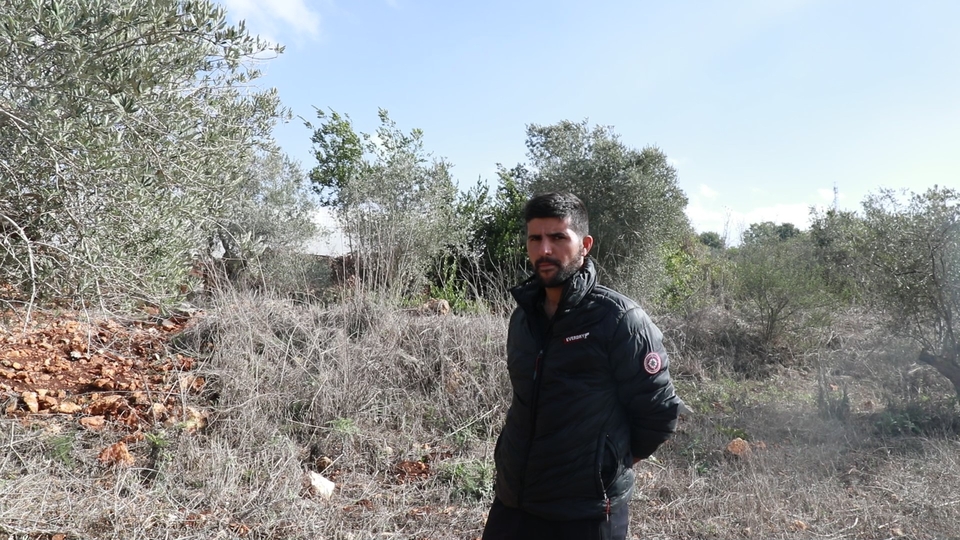In South Lebanon, Cultivating Resistance Against Israel’s “Substance from Hell”
On the morning of Friday, October 17, Oday Abou Sari was tending his cabbage, cauliflower, and okra amid the resounding whistling and explosion of white phosphorus artillery shells. The Israeli occupation forces had been firing white phosphorus since two in the morning. Oday, unfazed, entertained himself by counting the detonations. “I counted 184 bombs before losing interest,” the 29-year-old farmer told The Public Source.
Oday and his neighbors have long been accustomed to farming under the bombardment of the Israeli settler-colony next door. He lives in Dhayra, a Lebanese village less than one kilometer from the Blue Line, the UN-designated boundary that demarcates southern Lebanon from Israeli settlements built on occupied Palestinian and Lebanese towns. Facing Dhayra is the Israeli settlement of Jordeikh that was once populated by the Arab al-Aramshe tribe.
As Oday listened in his field, the bombs got closer, their noise more intense. His father called him inside the house. They secured all the windows and doors, hoping to prevent the smoke from seeping into their home. But the rooms quickly filled with a thick white smoke. “We couldn’t even see our own fingers,” said Oday.
Oday and his father put damp towels over their mouths, following advice they had seen on a WhatsApp group, but the smoke had already penetrated Oday’s lungs. Weeks later, he was still struggling to breathe.
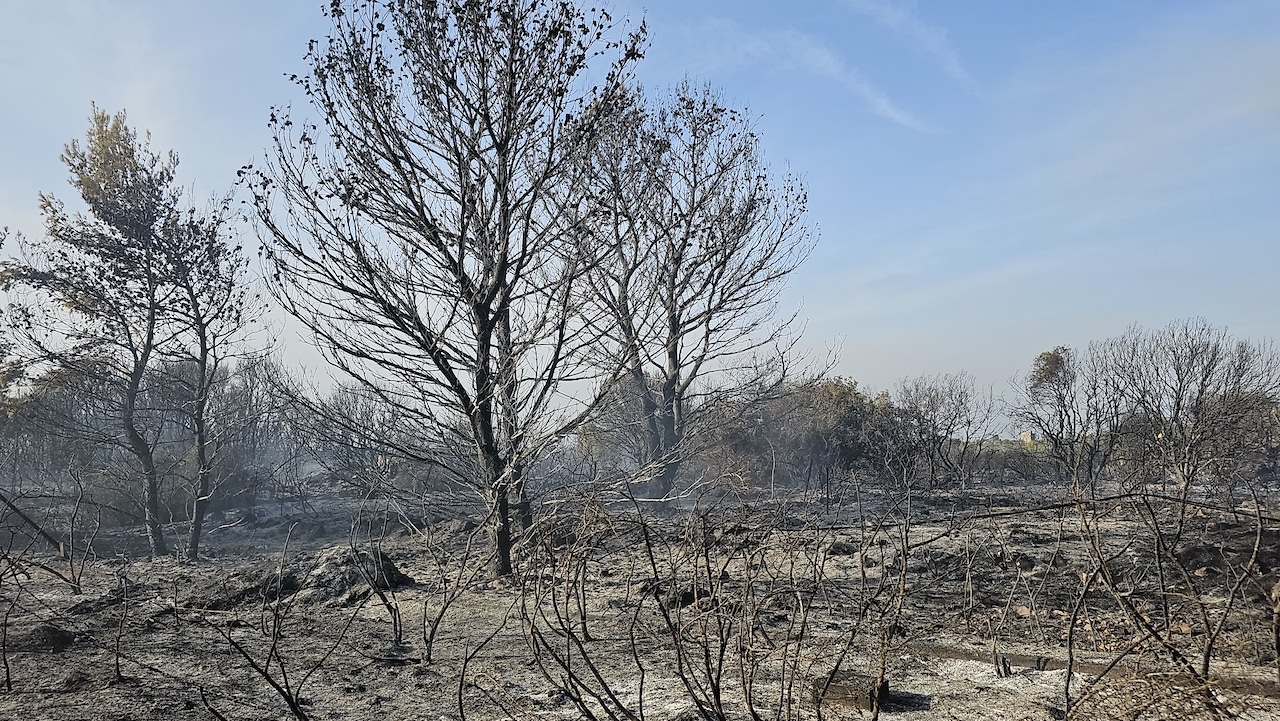
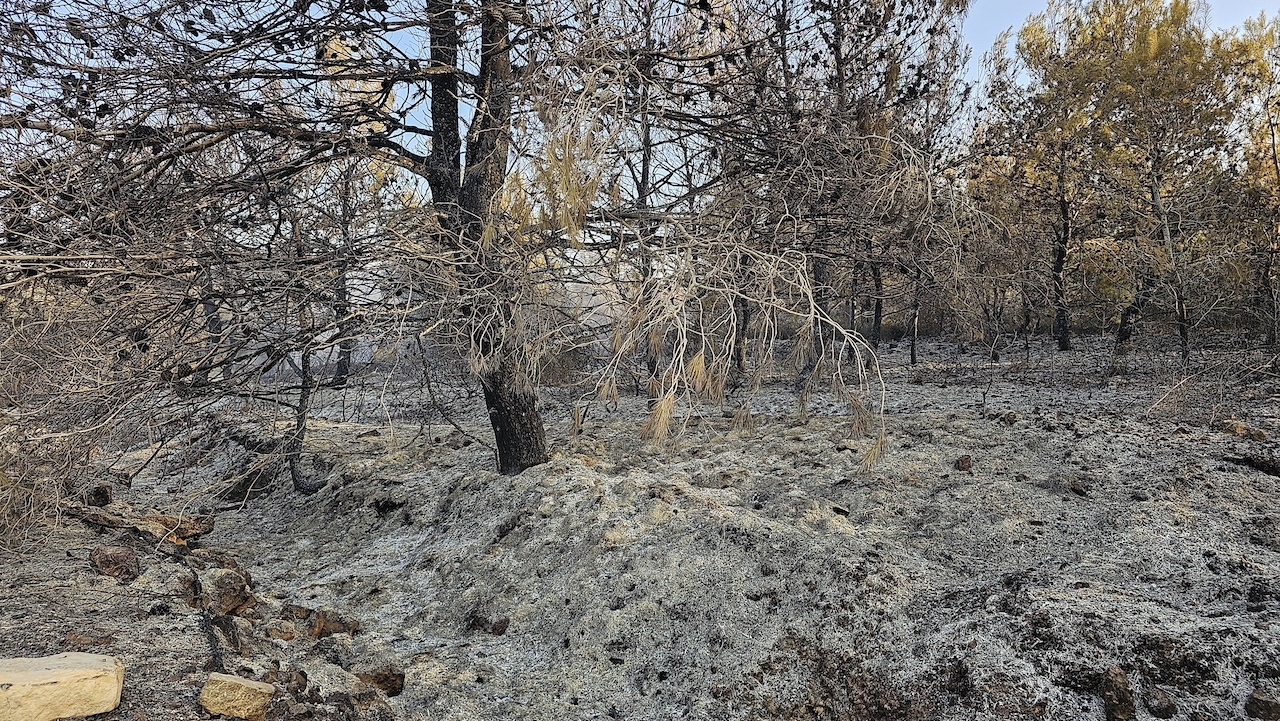
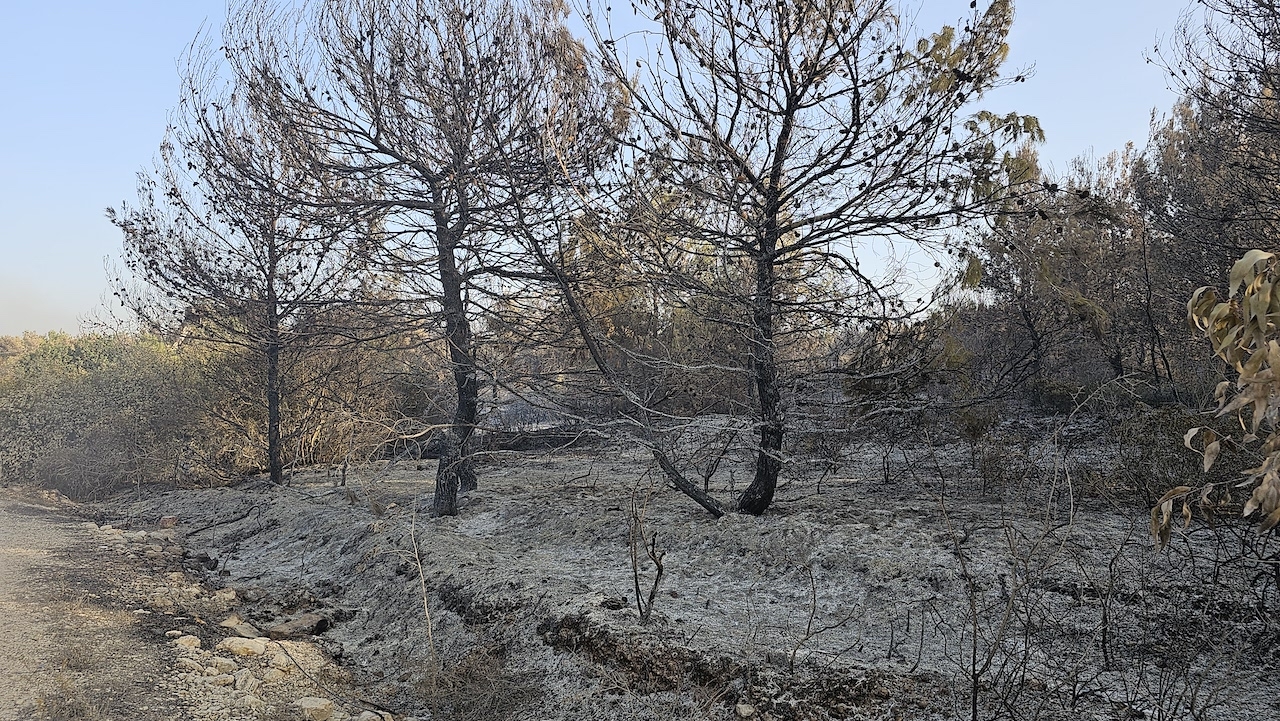
Forests burned by white phosphorus munitions in Naqoura. Naqoura, Lebanon. November 3, 2023. (Photo courtesy of The Green Southerners)
As Israel’s indiscriminate bombing of southern Lebanese villages continued, white phosphorus munition killed six of Maher al-Sayed’s cows.
“I saw them die in front of my eyes after I had seen them born from their mothers’ wombs, after I fed them, raised them, and spent time with them,” said Maher, a cowherd in Kfar Kila whose farm was saturated with white phosphorus smoke. “I had been with them for three to five years. I see them more than my own children.”
Maher was sitting next to one of his dying cows as he spoke to The Public Source over the phone. The others had already succumbed to pulmonary hemorrhages, bleeding from their mouths and noses after breathing in white phosphorus smoke.
“They are dying one after the other,” he said, his voice heavy with grief.
His remaining cows have stopped eating, drinking, and producing milk since the bombardment. Their hips and legs are weak, he said, and their ears are droopy. “I wish these cows were dead rather than crushing me with their untreatable illness,” he said. “Who wishes for his source of livelihood to die?”
Israel’s long-term goal is to sever the deep connections southerners have with their villages by rendering the lands barren.
Maher and Oday are just two of dozens of farmers in southern Lebanon whose agricultural lands were burned by US-supplied white phosphorus shells fired by the Israeli military. Over the past five months, in parallel with the genocide it is carrying out in Gaza, Israel’s military has also committed a series of war crimes inside Lebanon. In addition to the murder of Reuters journalist Issam Abdallah, and the killing and injuring of more than 200 other Lebanese civilians, the Israeli military has been waging a war against the land itself, burning acres of land, crops, and centennial olive trees with with weapons that are illegal when deployed against civilians, or in civilian settings — such as farms.
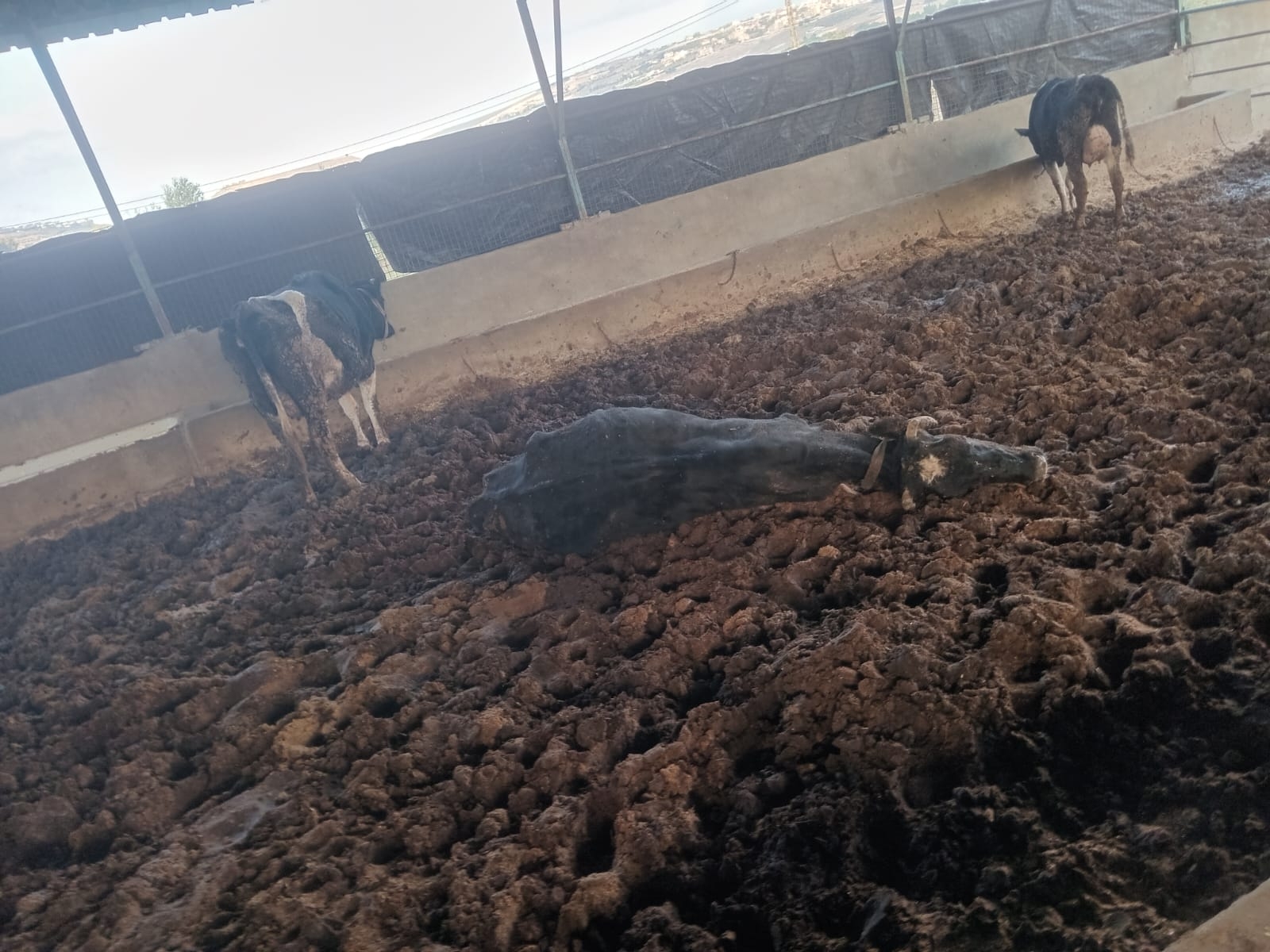
Six of Maher al-Sayed cows died from pulmonary hemorrhages caused by white phosphorus munitions fired by Israel on South Lebanon. Kfar Kila, Lebanon. October 16, 2023. (Photo courtesy of Maher al-Sayed)
The immediate impact of white phosphorus attacks — economic, environmental, and psychosocial — is devastating. And while the long-term damage is little studied in Lebanon, studies from around the world point to serious and sometimes fatal consequences to the health of people and animals.
These attacks are just the latest in Israel’s long history of war and occupation in south Lebanon. Environmental and anthropological experts who spoke to The Public Source say that Israel’s long-term goal is to sever the deep connections southerners have with their villages by rendering the lands barren. But this strategy, despite its brutality, has not succeeded in past invasions and wars.
White Phosphorus: “A Substance From Hell”
Since October 8, Israel has been continuously shelling southern Lebanon with different types of munitions — especially in the vicinity of the Blue Line. Israel has killed at least 70 civilians in the south, and displaced more than 89,000. Amnesty International documented the Israeli occupation forces’ use of white phosphorus bombs between October 10 and 16 on the towns of Dhayra, Aita al-Chaab, and al-Mari. From October 8 until March 1, 2024, Israel has conducted 139 white phosphorus attacks on dozens of towns including Kfar Kila, Mays al-Jabal, Houla, according to data from the Armed Conflict Location & Event Data Project.
Israel has conducted 139 white phosphorus attacks on dozens of towns.
White phosphorus is an incendiary and toxic substance usually used in wartime to create a dense smoke screen. White phosphorus bombs ignite upon contact with oxygen, burning at more than 800 degrees Celsius and producing thick and acrid white smoke with a pungent smell of garlic. A blast wave can scatter fiery, waxy particles over several hundred square meters.
“It’s a substance from hell,” environmental researcher at the American University of Beirut (AUB) and activist Abbas Baalbaki told The Public Source.
The substance can burn through human flesh and lead to a painful death, according to a study on burn injuries, in addition to causing severe respiratory issues, as seen in people hospitalized in Sur. “We were coughing, feeling nauseous, and vomiting for over a week,” Maher said.
The bombs also burned through many of Oday’s fields, even melting the pipes for water irrigation.
“It was a disaster! All my crops were ruined. All the lettuce, cabbage, cauliflower, and two and a half dunams of my okra field were gone,” he said in between long pauses. “I poured my entire soul into this land.”
Oday has been farming since he was 15, inheriting both the land and agricultural knowledge from his parents. He has supported his wife and two children, a 4-year-old and an 8-month-old, with the revenue of the land. But the Israeli shelling has left the Abou Sari family uncertain about the safety and health of the soil that feeds them.
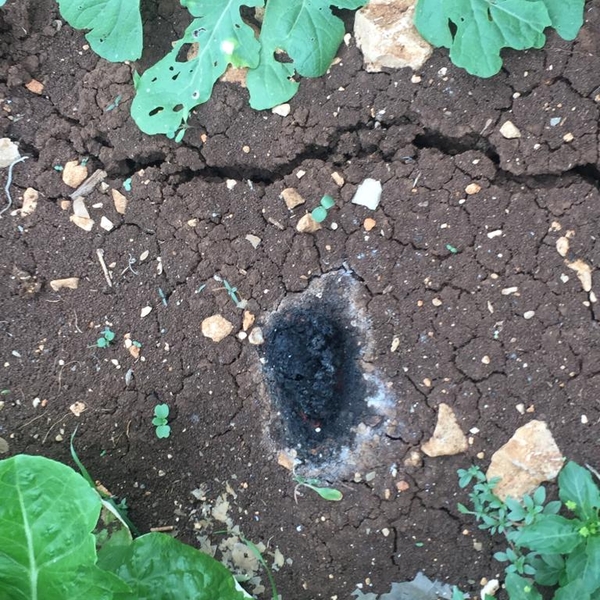
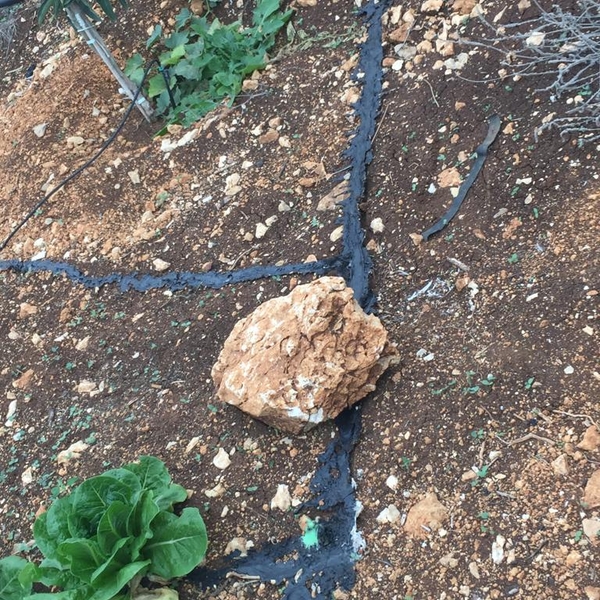
White phosphorus munitions burned the irrigation pipes in Oday Abou Sari’s farms in Dhayra. Black residue also contaminated the soil. Dhayra, Lebanon. October 18, 2023. (Photo courtesy of Oday Abou Sari)
Caretaker Agriculture Minister Abbas Hajj Hassan stated on November 20 that Israeli bombardments had killed some 900 chickens and cattle, and damaged 250 beehives, while causing fires in 53 villages across the South and Nabatieh governorates. Israeli attacks have burned 7.95 million square meters of land since October 8, according to the National Center for Scientific Research.
The attacks also destroyed more than 47,000 olive trees and damaged at least 60 greenhouses and water irrigation infrastructure, causing huge economic losses for farmers with repercussions lasting beyond the current harvest season.
“All of my work is based on agriculture,” Oday told The Public Source. In addition to the loss of his winter harvest, he also lost around $5,000 in equipment, fertilizers, and crops.
Similarly, Maher is incurring expenses in the thousands of dollars per month to shelter his cows in farms away from the rain of missiles, even as his surviving cows now produce half the amount of milk they used to. Maher also noted that the plowing of fields in preparation for sowing wheat was more than a month behind schedule due to farmers’ inability to access their lands.
Remains of white phosphorus that were fired by Allied forces during World War II in France re-ignited as recently as 2022, severely burning a beachgoer who had picked up innocuous-looking rocks from the sea.
On top of the immediate and short-term concerns, remains of white phosphorus can stay dormant for a long time when covered in soil — only to reignite spontaneously when re-exposed to oxygen. While the substance inside the clump is active, the outer protective layer appears as innocuous black dots in the soil, which Baalbaki warned against touching.
Baalbaki collected samples of soil in southern Lebanon after the recent attacks. Upon re-exposing it to air one month later, the white phosphorus remains in those samples flared up, he told The Public Source.
“The samples were still toxic, active and had very strong fire power. One of the samples, a few grams, stayed lit and spit fire for 10 minutes.”
The results of his experiment corroborate observations from elsewhere in the world. Remains of white phosphorus that were fired by Allied forces during World War II in France re-ignited as recently as 2022, severely burning a beachgoer who had picked up innocuous-looking rocks from the sea.
Baalbaki warned that unattended forest lands are the most at risk, since they are less likely than agricultural fields to be cleaned up by demining efforts.
An Uncertain, Poisoned Future
While immediate toxicity and fire risk caused by white phosphorus are clear, experts don’t exactly know what the long-term environmental consequences might look like for the people and agriculture of the south.
Two studies from the 1990s found that phosphorus particles persisted in the sediments, and poisoned local birds in Alaskan salt marshes where the U.S. army had carried out white phosphorus testing since 1949. Even though Israel shelled Lebanon with white phosphorus repeatedly between 1982 and 2006, there have not been any local studies on its long-term impact due to a lack of resources, political sensitivities, and difficulty in accessing samples, Baalbaki said.
The varying composition of weapons containing white phosphorus also means scientists may be reluctant to transpose the conclusions from one study to another. Many experts, however, are putting forward hypotheses based on the substance’s chemical formula. These conclusions can be made with high, but not absolute, certainty. Baalbaki suggested there was a slim, but possible, chance that small particles could infiltrate water streams, seeping into plants and wildlife.
Rami Zurayk, a professor of ecosystem management at AUB, told The Public Source that a research team at the university was working on developing methods to study white phosphorus using available equipment and material. Until then, Zurayk is hesitant to generalize conclusions based on studies conducted abroad. “We are fumbling around in the dark, but we will get there eventually,” he said.
“The first question they ask is ‘Where are the olives from?’ and we don’t want to lie to our people.” —Oday Abou Sari, farmer from Dhayra
Meanwhile farmers are worried that their surviving crops might be unfit for animal and human consumption. Israel’s white phosphorus munitions did not burn Oday’s 30-year-old olive trees, but they did cover the fruits in the smoke’s residues. He is worried that potential buyers will be scared off.
“The first question they ask is ‘Where are the olives from?’” he said, “and we don’t want to lie to our people.”
Today, Oday remains in his home in Dhayra, managing what’s left of his crops, aware that he works under the watchful eyes of Israeli warplanes. He focuses exclusively on his surviving avocado trees, and has stopped all other farming work in fields he fears have been polluted by white phosphorus. He’s sent soil samples for testing and is awaiting the results.
“I place my trust in God and believe he will be the one to guard my soul,” he said. “If I don't take care of these avocados, which cost me a fortune to grow, they will wither away for nothing.”
Maher has similar worries that his cows will not have clean water to drink or safe grass to graze on come next spring.
“The notion that everything in the South is polluted harms our southern farmers, and that’s why the enemy targets this region.” —Abbas Baalbaki, Environmental Researcher at the American University of Beirut
Despite the damage to this year’s harvest, Baalbaki urged the public not to jump to conclusions either way, as there are no studies that confirm or deny whether white phosphorus can infiltrate produce.
“Panic doesn't help, it brings economic consequences,” he said. Not all areas in the South faced exposure to white phosphorus, so the entire reputation of southern agriculture should not be tainted by fear of contamination, he cautioned. While it’s too early to predict the impact on produce in the region, Baalbaki said that land and crops situated 100-200 meters away from the targeted areas that do not have visible residue of the munitions are most likely safe.
“The notion that everything in the South is polluted harms our southern farmers, and that's why the enemy targets this region,” Baalbaki said.
If contamination occurs, its effects on the economy and food safety would extend beyond neighboring towns, Zurayk noted. Much of the south’s produce supplies big cities such as Sur, Nabatieh, and Saida. “Any shakiness in the agriculture sector will affect the availability of fresh and local produce in the market,” he added.
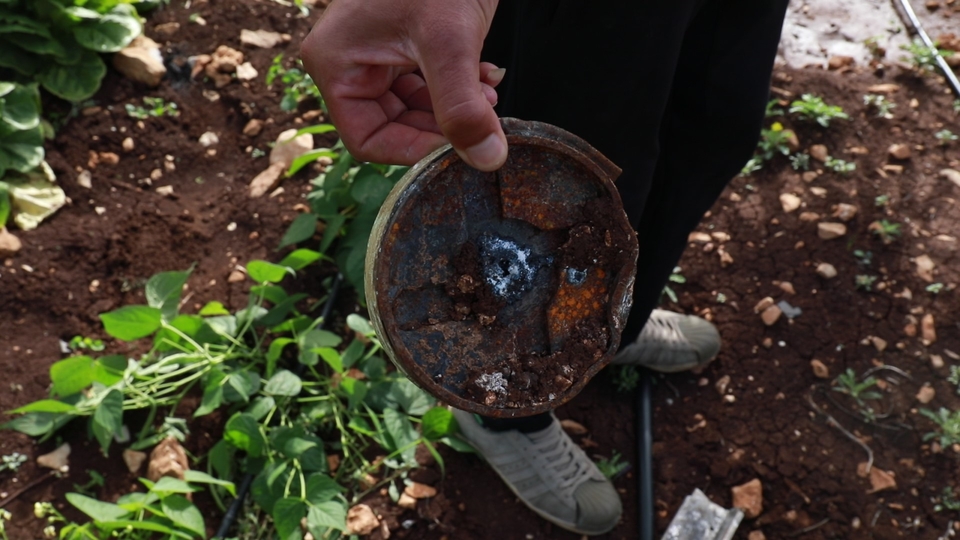
Oday Abou Sari holding an exploded burster of a white phosphorus shell that struck his farm, burning his harvest for the year in Dhayra, Lebanon. November 26, 2023. (William Christou/The Public Source)
The possible impact of Israel’s carpet bombing of southern Lebanon on agriculture is reminiscent of a scorched-earth policy, which consists of destroying enemy lands, belongings, and livestock with the intention of spreading terror and discouraging resistance. International humanitarian law defines the deliberate destruction of agricultural areas for the production of foodstuffs, crops, livestock, drinking water installations and supplies, and irrigation works — all considered “indispensable to the survival of the civilian population” — as a war crime.
While severe damage in southern Lebanon has been mostly, but not exclusively, limited to houses, green spaces, and agricultural fields, the Israeli war on Gaza has been indiscriminate. The Israeli occupying forces have dropped tens of thousands of bombs targeting houses, farms, parks, hospitals, and schools and have killed more than 30,500 Palestinians.
These types of aggressions are not new to the Israeli army. In 1982, Israel invaded Lebanon to debilitate any form of Palestinian resistance under the pretense of attempting to stop Palestine Liberation Organization (PLO) attacks from the area. The Israeli forces reached as far north as the Lebanese capital, killed tens of thousands of people, and imposed a siege on the predominantly pro-Palestinian West Beirut for over two months, culminating in the massacre of Sabra and Shatila when the Israeli-allied Christian Phalange militia massacred between 2,000 and 3,500 people in the Sabra and Shatila refugee camp in Beirut.
Much of the South remained under occupation for decades beginning in 1985 even though Israel had started its invasion in 1978 during Operation Litani. Throughout this time, villagers endured constant gunfire, frequent village raids, imprisonment, checkpoints, and road closures that severely impacted their lives and the local economy. The occupation army had also set up a detention center in Khiam, where thousands were abducted and tortured. The local population eventually developed local resistance movements to protect their homeland against the occupiers and liberated the South in 2000.
Resistant Crops and Rooted People
Agriculture has long been the main source of livelihood for many families in southern Lebanon. Southern agriculture broadly relies on rainfed crops — Baaliyeh in Arabic, a reference to the ancient Canaanite sun god Baal — that thrive in arid conditions without irrigation, anthropologist Munira Khayyat, author of A Landscape of War, told The Public Source.
“In a landscape that is as battered and as neglected as south Lebanon, only these kinds of crops grow,” Khayyat said. “The woodlands in south Lebanon, in particular, are naturally acclimated to seasonal conflagrations and seasonal fires,” she added. “So war kind of folds into this sort of naturalized rhythm, and they are able to regenerate in the aftermath of wars.”
The south’s primary and most popular production remains olives and olive oil, according to agricultural engineer Wael Yammine. The olive tree has been a steadfast companion of the people of southern Lebanon and the Levant for millennia.
“The woodlands in south Lebanon, in particular, are naturally acclimated to seasonal conflagrations and seasonal fires. So war kind of folds into this sort of naturalized rhythm, and they are able to regenerate in the aftermath of wars.” —Munira Khayyat, author of A Landscape of War
While olive trees take decades to bear fruit, their resilience and low-maintenance nature has helped sustain many southern families through conflict and harsh weather, Yammine told The Public Source.
“These are resilient trees that endure droughts and defiantly weather severe storms,” Yammine said.
Other resistant crops include figs, grapes, and tobacco, which Khayyat said the southern region relied on during wars and invasions.
During the Israeli invasion and the wars of the 1980s, southern areas grew more dependent on agriculture as people established agricultural lifelines on their lands, Khayyat said.
Fighting for home and land in southern Lebanon is an existential struggle, she added. Having a home in the South builds a sense of ownership, identity, and connection — not just for those who live there, but also for families who live abroad but invest in building a home in their villages.
“There's a lot of affective, symbolic, and emotional attachment to those landscapes,” she said, “and anybody who still has a home in south Lebanon holds on to it with everything they have.”
However, this connection is currently at stake. Baalbaki explained that attachment to land is tied to it remaining abundant and fruitful, rather than a “hazardous dumpster.”
Overwhelmed by stress and frustration, Oday is among those pondering immigration for the sake of his children.
“I am the son of this land and do not want to leave,” he said, anger tangible in his voice. “But I cannot invest my energy into this dream and land of mine only to see it destroyed and taken away from me.”
Israel has two different strategies for Palestine and south Lebanon. Palestinians are to be exterminated in order for settlers to replace them. In south Lebanon, it aims to remove all signs of life.
According to Zurayk, Israel has two different strategies for Palestine and south Lebanon. Palestinians are to be exterminated in order for settlers to replace them. In south Lebanon, it aims to remove all signs of life.
During the July 2006 war between Hezbollah and the settler-colony, the occupation littered southern Lebanon with cluster munitions that released approximately four million smaller explosive bomblets, covering about 1,400 square kilometers north and south of the Litani River. The Lebanese Army, UNIFIL, and multinational nonprofits such as Mines Advisory Group had removed 90 percent of these munitions as of last year; the remaining artillery was expected to be eliminated by 2026 — 20 years after the war.
Logic of Force vs. Logic of Life
It is still too early to estimate the extent of the decontamination process once Israel stops firing white phosphorus into Lebanon, Associate Director of the Nature Conservation Center at AUB Antoine Kallab told The Public Source. “Those responsible for the harm must pay for the damage,” Kallab emphasized.
Israel has previously acknowledged using white phosphorus in Lebanon in 2006, without facing consequences. Southerners are constantly fighting for lives in their ancestral hometowns, Khayyat said, and their resistance takes on various forms, not limited to armed struggle.
While Israel is targeting all nexuses of life including agriculture, said Khayyat, “south Lebanon is a place that the Israelis just don’t know what to do with because no matter how hard they bash it, people are refusing to no longer live there.”
Lebanon, alongside Palestine, has always been part of the struggle against the settler colonial Zionist state of Israel, Khayyat added. Since October 8, 234 fighters from Hezbollah and other groups have died defending the South from Israeli aggression.
“There’s this logic of force on the side of the Israeli war machine, but there’s logic of life on the other side.” —Munira Khayyat, author
The fact that the Lebanese resistance was successful in liberating most of the South (except the Shebaa farms) from Israeli occupation in 2000 is a historical event that can bring hope in Palestine, she said. “There’s this logic of force on the side of the Israeli war machine,” she added. “But there’s logic of life on the other side.”
Choosing to stay on the land is a form of resistance in itself. “The message, which you see in the ongoing genocide in Gaza, is that a world-ending deadly force doesn't actually end life,” she said, “but it cultivates a stronger resistance.”
